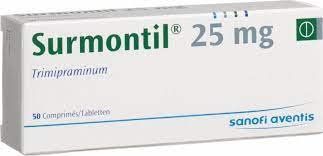This is an automatically translated article.
Aminazin is an antipsychotic drug used in the treatment of vomiting and dyskinesia. So what does Aminazine do?
1. Effects of Aminazin brand-name drug
Before learning about the use of Aminazin, let's understand what Aminazin is?.
Aminazin, also known as chlorpromazine, is an antipsychotic drug with antiemetic and antikinetic effects. Chlorpromazine is a phenothiazine derivative with primary psychotropic use. In addition, the drug Aminazin has sedative, antibiotic, antiemetic and antiserotonergic effects and is used to treat conditions such as:
Types of schizophrenia Manic phase of bipolar disorder Nausea or vomiting, hiccups difficult to treat Preoperative sedation Intermittent acute porphyria Supportive in the treatment of tetanus Antipsychotic drugs are dopamine antagonists, D2-dopamine receptor blockers in the striated striated ridges, funnel tubercles , between the cortex and between the limbic gyrus of the brain. In addition, Aminazin antagonizes the dopamine receptors of the medulla oblongata and the anterior part of the brainstem. Antipsychotic effect due to its ability to block D2 receptors of the midcortical and mid-glare gyrus. As for the antiemetic effect, it is due to the blocking of dopamine receptors in the medullary chemoreceptor excitatory region and by blocking the vagus nerve of the gastrointestinal tract. This effect may be enhanced by the sedative, antihistamine, and anticholinergic effects of phenothiazines. The sedative and calming effects are due to the alpha-adrenergic blocking and histamine H1 antagonists of phenothiazines.
In addition, some other effects of the drug are not listed on the approved drug label, but in some cases the doctor may prescribe the use of Aminazin. Therefore, before taking the medicine consult your doctor.
2. How to use Aminazine
Aminazin is prepared in the form of a solution for injection, can be injected intramuscularly with a diluted solution of Aminazin with sodium chloride solution to prevent irritation at the injection site and intravenously used only in severe hiccups or in tetanus, when surgery. Dosage will be based on the condition and age of the patient.
For mental disorders: Patients should be injected intramuscularly when there are severe disorders, with an initial dose of 25-50mg and can be repeated in 1 hour and then every 3-12 hours. The maximum dose is 1 gram/day. Treatment of nausea and vomiting: The patient is first injected intramuscularly 25mg and then 25-50mg, injected every 3-4 hours if needed. Preoperative sedation: Preoperative dosage is 12.5-25mg intramuscularly. Treatment of hiccups: Patients inject intramuscularly at a dose of 25-50mg/time, inject 3-4 times a day or intravenously infuse 25-50mg diluted in 500-1000ml of sodium chloride injection solution and infuse slowly at high speed. at 1ml/min, and monitor blood pressure during treatment. Treatment of porphyria: 25mg intramuscularly every 6-8 hours until the drug can be taken. Support for treatment of tetanus: Intramuscularly at a dose of 25-50mg/time, 3-4 times/day with the dose can be increased gradually if needed. Intravenous infusion of 25-50 mg diluted to a concentration of at least 1 mg/ml with sodium chloride injection solution and infused at a rate of 1 ml/min.
3. Undesirable effects when using Aminazin
Aminazin can cause some undesirable and common side effects that can be mentioned as:
Drowsiness Lethargy Walking dragging Restlessness Anxiety Stress Abnormal movements such as slow or even uncontrollable Controllable Difficulty sleeping, difficulty staying asleep Changes in skin color Dry mouth Swelling of the nose Increased appetite, weight gain Breast lactation, enlarged breasts Amenorrhea Decreased libido Difficulty urinating Constriction or dilation of pupils Fever Muscle stiffness Loss of vision, especially at night, seeing everything as brown Before prescribing a drug, a doctor always considers the benefits and effectiveness of Aminazin. When using Aminazin can still occur unwanted effects. Therefore, when there are unusual symptoms, especially when a severe allergic reaction occurs with accompanying signs such as severe dizziness, difficulty breathing, rash, ... the patient needs to be informed. Immediately notify the doctor or nurse for immediate medical intervention.
4. Some notes when using Aminazin
Some notes when using Aminazin include:
History of allergy to Aminazin hypersensitivity reaction to any other allergy. Aminazin may contain ingredients that don't work and could cause an allergic reaction or other serious problems. Report any medications you are taking including prescription and nonprescription drugs, herbs and supplements, foods, dyes or preservatives. Aminazin is contraindicated in patients at risk for angle-closure glaucoma and urinary retention due to urethral and prostate disorders. Use with caution in cases of elevated body temperature, where treatment should be discontinued because this sign may be one of the factors of neuroleptic-induced malignant syndrome. In addition, it is also necessary to be wary of some conditions such as elderly people such as sedation, hypotension, patients with fibrillation paralysis, patients with severe cardiovascular disease, kidney failure, liver failure. Enhanced monitoring when treating patients with epilepsy because chlorpromazine may lower the seizure threshold. For pregnant women, it is necessary to limit the duration of drug use during pregnancy, so the dose should be reduced at the end of pregnancy, and the neurological and digestive function of the neonate should be monitored for a period of time. time. For women who are breast-feeding, do not breast-feed during treatment. Chlorpromazine is excreted in breast milk. If you forget to take a dose of Aminazin, take it again as soon as possible. However, if it is almost time for your next dose, skip the missed dose and continue injecting as usual. Do not use more drug than the treatment regimen. Aminazin overdose or ingestion can cause serious symptoms such as nausea, vomiting, abdominal pain, shortness of breath, fainting,...
5. Drug interactions
Some drugs that can interact with Aminazin include:
Contraindications to the combination with levodopa Alcool: because alcohol enhances the sedative effect of neuroleptics, decreased concentration can be dangerous while driving or using machinery. Guanethidine and similar drugs: Chlorpromazine inhibits the antihypertensive effect of guanethidine and should be replaced with another antihypertensive agent. Lithium: causes confusion and sometimes rapid increase in serum lithium Sultopride: increases the risk of ventricular arrhythmias and mainly causes torsades de pointes and is associated with electrophysiological effects. Antidiabetic drugs: High doses of chlorpromazine may increase blood sugar. Inform patients to enhance self-monitoring of blood glucose and urinary glucose. Depending on the situation, it is possible to adjust the dose of antidiabetic drugs during the combination with neuroleptics and after stopping treatment. Salts, hydroxides and oxides of Al, Mg and Ca: reduced gastrointestinal absorption of neuroleptics. Medicines can be taken more than 2 hours apart. Drugs for the treatment of hypertension are associated with an increased antihypertensive effect and the risk of orthostatic hypotension due to a combination of effects. CNS depressants: analgesic and antitussive morphine derivatives, most H1 antihistamines, benzodiazepines, barbiturates, clonidine and others in the same class: increased CNS depression and possible after effects The effects are heaviest for those requiring concentrated activity. Atropine and substances with atropine-like effects: increased side effects of the atropine group include constipation, urinary retention and dry mouth.
6. How to store Aminazine?
Store Aminazin with solution for infusion at room temperature below 30 degrees Celsius, protect from light and avoid humid places. Do not store Aminazin in a humid place or in the freezer and keep away from heat and open flames. Different medicines will have different storage methods, so read the Aminazin storage instructions carefully on the package, or ask your pharmacist. Keep Aminazin out of the reach of children and family pets. When the medicine has expired or is damaged and cannot be used anymore, dispose of it and dispose of it properly. Do not arbitrarily dispose of Aminazin into the environment such as water pipes or toilets unless requested.
Please dial HOTLINE for more information or register for an appointment HERE. Download MyVinmec app to make appointments faster and to manage your bookings easily.













